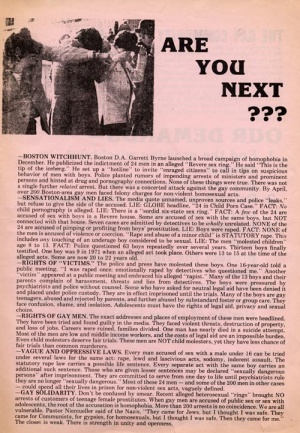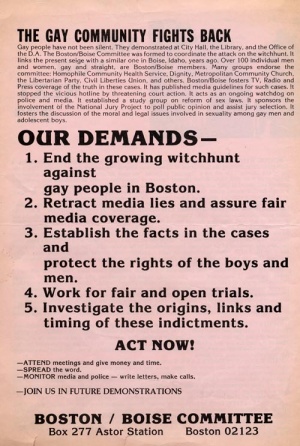One of our staff members is contributing considerably to a News Archiving service at Mu. Any well educated (Masters, PhD or above) users who wish to make comments on news sites, please contact Jim Burton directly rather than using this list, and we can work on maximising view count.
Boston-Boise affair



The Boston/Boise Affair was a pivotal chain of events in the history of the struggle for sexual rights.
Arrests
On December 8, 1977, Garrett Byrne, district attorney (DA) from Suffolk County, which includes all of Boston and three smaller surrounding communities in Massachusetts, called a press conference to announce the indictment of 24 men on multiple charges of statutory rape involving boys ages eight to thirteen. He said the men had allegedly lured the boys with marijuana, money, and games, and then raped and photographed the victims. He also claimed the men were part of a sex ring that was just the "tip of the iceberg" and that there would be more indictments as the investigation progressed. (Cohen)
The extensive media coverage never questioned the accused men's guilt or Garrett Byrne's assertions, but instead vilified the defendants and published their pictures, names, and addresses despite the constitutional presumption of innocence. The 24 men indicted by Garrett Byrne came from all walks of life, from a bus driver to the headmaster of a prestigious prep school. To say that their lives were shattered by the indictments would be an understatement. Most lost their jobs, many lost their families, and all lost their reputations from the media coverage.
Yet as the cases unfolded it became clear that many of the facts and accusations were fabricated. Most of the men didn't know each other. There was no sex ring. The vast majority of the accused men had had sex with one of two fifteen-year-old hustlers from Revere, Massachusetts, sometimes in the apartment of a man named Richard Peluso. Peluso had been having sex with local boys in Revere for fifteen years and was arrested on child molestation charges six months before the sex ring indictments. None of the boys involved was under thirteen.
John Mitzel, author of the definitive work on these events, The Boston Sex Scandal, explains that the "sex ring" allegations came about as a result of Peluso's arrest: "Photos seized in Peluso's apartment were used to identify 64 local youths. All were collared by cops and forced to spit out names. As it turned out, only thirteen agreed to cooperate, mostly under pressure by police, priests, and psychiatrists." The testimony of those thirteen boys led to the 24 indictments.
The arrests were widely seen as part of the DA's strategy for re-election to an eighth term. Byrne had a history of using the investigative powers of the DA's office to "uncover" sensational vice "rings" of one sort or another as election time approached, using the hysteria to keep his name in print and his image as a public protector and crusader against vice intact, and no one had ever dared to defend those he targeted.
Boston/Boise Committee
But this time there was a surprise. On December 9, 1977, members of the radical Fag Rag collective formed the Boston/Boise Committee (B/BC) to defend the rights of the accused men as well as the boys. Boise was a reference to a similar witch hunt that had occurred in Boise, Idaho in 1955, when hundreds of gay men, including many prominent citizens, were arrested for sex crimes with teenagers, about which John Gerassi wrote in The Boys of Boise.
In addition to the sensational and biased media coverage, the B/BC was concerned about a special "hotline" set up by the district attorney's office for citizens to call in anonymous tips about men who had sex with boys under sixteen. The Hotline moved the scandal into the realm of a witch hunt.
Seventy-five people were present at the offices of Gay Community News a few days after the arrests for an emergency meeting called by the B/BC. An assistant district attorney, Thomas Dwyer, agreed to meet with three members of the B/BC to discuss the group's demands, including the resignation of Garrett Byrne and an end to the Hotline. But the DA refused both, so on December 15, 1977, about thirty people demonstrated in City Hall Plaza and then marched directly to the DA's office and confronted Assistant DA Dwyer, but once again Byrne refused to end the hotline. Finally, the B/BC took the matter to court. Knowing the court would have restrained them, the DA's office announced they had voluntarily discontinued the Hotline, making the case moot. (Cohen)
Conclusion
None of the defendants in the case went to jail. Garrett Byrne was defeated in 1978 by an assistant district attorney named Newman Flanagan. Byrne had assumed that most of the defendants would accept a plea to avoid negative publicity and jail, but to his surprise the vast majority wanted a trial, and all those trials would stress the resources of the county. Only one case actually went to trial: Dr. Donald Allen was charged with four counts of fellating a fifteen-year-old male hustler. Although he was ultimately convicted, the judge sentenced him to just five years probation - a signal to the other defendants, most of whom settled with a plea bargain and received light probation. (Cohen)
Although many wanted the Boston sex scandal to quietly disappear, it is not without legacies. While conducting legal research on Age of Consent laws, a subcommittee of the B/BC sponsored what turned out to be the first meeting of NAMBLA on December 2, 1978. The sex scandal also exposed the division within the gay community. Those seeking "acceptability" were opposed to any activities that might seem to condone sex between adults and minors.
See also
External Links/References
- The Boston/Boise Affair, 1977-78, by Art Cohen
- We Raise Our Voices - Sexual Freedom & Liberation
- The Boston Sex Scandal by Mitzel. Whole book on Greek-Love. Parts 1 2 3 4 5.